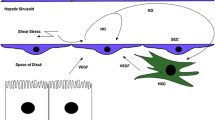Abstract
Defined microcirculatory disturbances have been demonstrated during the first hours after hemorrhagic shock involving complex pathophysiological mechanisms. Since clinical complications associated with the inflammatory reaction that accompanies shock and resuscitation become apparent within days, our aim was to establish an experimental model of hemorrhagic shock which simulates this clinical situation. Therefore, a nonlethal rat model was developed allowing for the investigation of the hepatic microcirculation by intravital microscopy up to 4 days after hermorrhagic shock.
Anesthetized Sprague-Dawley rats were subjected to hemorrhagic hyptension by blood withdrawal reducing MAP (mean arterial blood pressure) to 40 mm Hg. After 60 min of hypovolemic hypotension, the animals were resuscitated. After 1, 2, 3, or 4 days, sinusoidal perfusion pattern and leukocyte adhesion characteristics were investigated using intravital fluorescence microscopy. In separate, but parallel experiments, the time course of TNFα (tumor necrosis factor α) and ICAM-1 (intercellular adhesion molecule-1) mRNA expressio was examined in enriched parenchymal and non-parenchymal liver cell fractions by Northern blot hybridization.
At day 1, sinusoidal narrowing as seen in previous experiments a few hours after shock was not observed but occurred at days 2 and 3 after shock. Permanent adhesion of leukocytes to the sinusoidal endothelium reached a maximum at day 2 after shock and remained significantly increased until day 4 compared with controls. An early TNFα mRNA accumulation was observed in shock animals but not in sham operated controls. In contrast, a sustained expression of ICAM-1 and prolonged accumulation of white blood cells were observed.
The data reflect an early transient TNFα mRNA response and a sustained inflammatory reaction associated with shock and resuscitation. The inflammatory pathological alteration of the hepatic microcirculation after hemorrhagic shock are paralleled by a sustained disturbance of the sinusoidal flow patterns.
Similar content being viewed by others
Author information
Authors and Affiliations
Additional information
Received: May 14, 2000; revision accepted: July 10, 2000.
Rights and permissions
About this article
Cite this article
Bauer, C., Kuntz, W., Bauer, M. et al. Evidence for a Sustained Inflammatory Response of the Hepatic Microcirculation after Hemorrhagic Shock. Eur J Trauma 26, 176–184 (2000). https://doi.org/10.1007/PL00002441
Issue Date:
DOI: https://doi.org/10.1007/PL00002441




